Near field domain
Comparing the present investigation with the findings for the freestanding blade (Fig. 2a), it is concluded from Figures 3 to 5 that the overall stability behavior of a sectored vane cascade of four, five or six blades, as well as the main directions, for the most stable and unstable regions, remains the same. These directions are also not affected by the different amplitude distributions
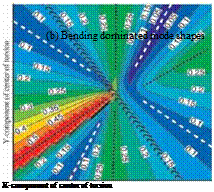 |
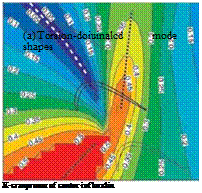 |
Figure 2. Freestanding blade cascade
from cases 1, 2, and 3. In all cases the stability of the reference sectored vane is more sensitive to a change in the pitching axis location along, rather than normal to, the surfaces of the airfoils.
The region of the most stable pitching axis locations begins slightly below the reference vane, passes its high curvature region and extends upwards along the pitch-wise direction of the cascade (see dashed line in Figs. 2a and 3-5). The most unstable direction (see dotted line in Figs. 2a and 3-5) of the pitching axis locations also begins below the reference vane and has two branches. One corresponding to a higher instability level is orientated upstream of the cascade approximately perpendicular to the cascade tangential direction. Another one with a lower level of instability passes the reference vane at approximately 60% true chord and is directed outside of the cascade normal to the aft part of the vane.
|
|
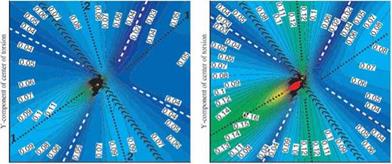
(a) Four-airfoil sectored vane
(a) Four-airfoil sectored vane
|
|
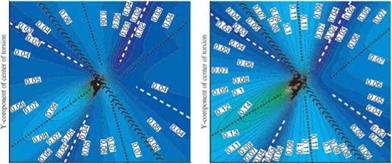
(b) ![]() Five-airfoil sectored vane (a) Four-airfoil sectored vane
Five-airfoil sectored vane (a) Four-airfoil sectored vane
|
|

(c) Six-airfoil sectored vane
(c) Six airfoil sectored vane
Figure 3. Case 1 vibration amplitude distri – Figure 4. Case 2 vibration amplitude distribution (far field domain) bution (far field domain)
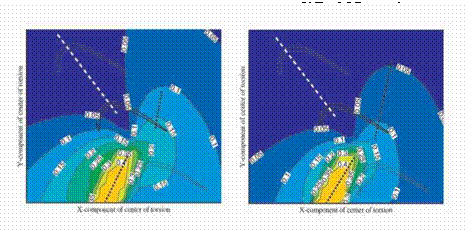
However, the absolute value of the average aerodynamic work is fairly different between the freestanding blade and multiple-airfoil sectored vanes. None of the four-, five – or six-airfoil sectored vane has a region of as high gradients in critical reduced frequency along the mid-section of the reference vane as the freestanding blade. Furthermore, the stability increase for a sectored vane is clearly seen: the shape of the domain with unstable pitching axis locations that the multiple-airfoil sectored vanes have at k=0.25 (for Case 1 amplitude distribution, Fig. 3), at k=0.35 (for Case 2 amplitude distribution, Fig. 4) or at k=0.2 (for Case 3 amplitude distribution, Fig. 5) is achieved for the freestanding blade already at much higher reduced frequency of k=0.5 (Fig. 2a).
Figure 5. Case 3 vibration amplitude distribution (near field domain)
Increasing the number of airfoils in a sector clearly affects the absolute value of the average aerodynamic work of the sectored vane with uniform (Figs. 3a – c) or internal blade dominated (Figs. 5a-b) vibration amplitude distribution. For similar curved contour lines the values of the critical reduced frequency corresponding to these lines are higher for the sectored vane with a lower number of airfoils in sector. In the domain near the aft part of the suction surface of the reference vane an increase in the number of blades from four to six leads to a decrease of 0.05 in the critical reduced frequency values. The size of the domain corresponding to the critical reduced frequency less than 0.05 is significantly larger for the six – than for the four-airfoil sectored vane. For the sectored vane displacement with the edge blades dominated (Figs. 4a-c) the infhence on the absolute value of the average aerodynamic work of the number of airfoils in the sector is much less.
A comparison of Figures 3 to 5 shows the effect of a vibration amplitude ratio between the edge and internal blades of the sector on the aerodynamic stability of the sectored vane. A change in the vibration amplitude distribution from the uniform to the internal blades dominant stabilizes the sectored vane. While choosing the vibration amplitude with the edge airfoils dominant decreases the stability (Figs. 4a-c). The size of the domain with the critical reduced frequency less than 0.05 becomes smaller. While near the aft part of the reference vane suction surface the maximum of the critical reduced frequency values increases.











